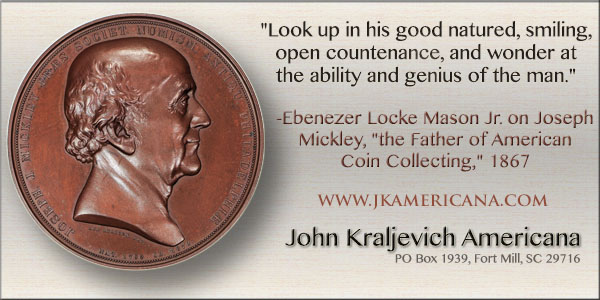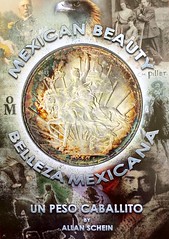
PREV ARTICLE
NEXT ARTICLE
FULL ISSUE
PREV FULL ISSUE
AUTHOR REBUTS MISPLACED NATIVIST CRITICISMAllan Schein of Salt Lake City, Utah writes: Attached is a Letter to the Editor that I believe supports the philosophy of the E-Sylum, inspired by an indirect circumstance that occurred in Long Beach last week. Coincidently, this piece I wrote several days prior to a piece by F. Michael Fazzari’s discussion of a somewhat parallel nature in the June 16 issue of Numismatic News.
The on-site seller was kind enough to offer my book for sale, and there were a number of people that spent considerable time perusing through the pages. Unfortunately, a few waited in vain while the sellers unsuccessfully tried to locate me on the bourse floor, to whom I whole heartedly offer my apologies. One individual however was a fellow from Mexico who told the supply company that since I was not of Mexican descent, I had no right to produce a book on a Mexican issue. It wouldn't surprise me if this was the same fellow that scolded me at the September 2014 Mexico City show. In an attempt to have a conversation, I asked if he spoke English, and was verbally reprimanded. He told me that if I want to do business in Mexico I should learn the language. Ironically, he told me this in English, then snubbed me. Nice fellow. I'm sure he works in the Public Relations department of a local corporation as some sort of friendship emissary. Unfortunately, I was not able to connect up with this critic, because I would have explained that knowledge should not be confined within national borders, and ask what he's done lately. Other than complain that someone produced a work about a Mexican coin issue nobody, not even one of his countrymen have managed to produce to date. Hmmmmm. The book is bi-lingual also, translated by the Mexican born numismatist, my good friend Roberto del Bosque. Even the graphic artist I worked with here in Salt Lake City, Eduardo Cuellar, is from Mexico City, and was educated there in the famed Art Institute. Now that's an International collaboration, in my assessment. The coin's creator, French sculptor and medalist Charles Pillet designed this coin, engraved the dies and struck the proofs in Paris. In 1911 the relief was modified slightly by Pillet, and the changes engraved by Charles Barber, chief engraver of the U.S. Mint at Philadelphia. So in actuality, the things that are Mexican about the coin are the name ESTADOS UNIDOS MEXICANOS on the obverse, the silver it contains and the fact that it circulated in Mexico. Its entire creation was conceived outside Mexico and thereafter presented for production to the Casa de Moneda. Again, in reality, it's as much an international coin as it is a sovereign issue. If books about Mexican numismatics were to be confined to those written by citizens of Mexico, or those with a connected heritage, the volumes that exist would be about half the current roster, maybe less. What if Clyde Hubbard, Dick Long, Theodore Buttrey, Don Bailey, Neil Utberg,, Hugh Guthrie, Elmer Powell, J.B. Parker, Mike Dunigan, Max Keech, Cory Frampton, Greg Meyer, Brian Stickney, Carlos Jara, Kent Ponterio and Simon Prendergast to mention a few, never wrote on Mexican Numismatics? The overall body of knowledge would be vastly diminished. Mexican authors and numismatists have produced some excellent work, but without the collaboration and contributions of the author/numismatists named above and others, the libraries of collectors on Mexican Numismatists would have many an empty bookshelf. We're living in the 21st century. Americans are living in Mexico, and Mexicans in North America. The world has become an International community, with knowledge garnered from all corners of the planet by people from every walk of life and every nation. There are few barriers to information that is accessible to any and all interested parties, unless you live in North Korea. So numismatic treatises of every sort, on every topic by people from the Planet over have and will continue to appear as they are created. To the individual that feels this should be restricted I can only surmise that he is either unable to produce or jealous of those who have. As a martial arts master, I find it practical, in the philosophy of Bruce Lee, to "use what is useful". Any technique that works has value, no matter the origin. The same goes for all knowledge, in my opinion. If there is a body of knowledge that can enlighten me on a subject, or increase my understanding of a coin series, I embrace it. As a student of numismatics I have learned that most everyone has something to teach, and conversely, we all have something to learn. Does it really matter where that knowledge comes from so long as it is accurate and useful? I don't think it does, but then, I try to keep an open mind because I don't know what it is I don't yet know. Every new article, new book, new insight into a coin or piece of currency adds to the overall body of numismatic knowledge. The more that's contributed no matter the source, so long as it is viable accurate information, is of value. I encourage everyone that has learned something that they believe was previously not known or not written about to put it down on paper and submit it to The E-Sylum for publication. The more contributors, the better. The US Mexican Numismatic Association has grown into a positive, influential, educational organization that networks hundreds of like-minded collectors, all with divergent but largely similar interests. The phrase "each one teach one" has been demonstrated over and over, and continues to expand along with that organization. The principle of shared knowledge is at the core of numismatics and no organization or publication illustrates that better than The E-Sylum.
Since when does one have to live in Greece to study ancient Greek coins? Scholarship knows no geographic bounds, as E-Sylum
readers are well aware. We have people in Ireland writing about Canadian numismatics, people in Germany studying Latin American
numismatics, and American authors writing definitive works on British Numismatic Literature. The impassioned critic should direct his
energies instead to encouraging native researchers (or shut up and write his own damn book). Coincidentally, one might see a parallel in
the discussion earlier in this issue about a British author writing about early American issues, but while an American is critiquing her
conclusions, no one is questioning their authority to research and write about the topic. -Editor
For more information about Allan's book, see:

Wayne Homren, Editor The Numismatic Bibliomania Society is a non-profit organization promoting numismatic literature. See our web site at coinbooks.org. To submit items for publication in The E-Sylum, write to the Editor at this address: whomren@gmail.com To subscribe go to: https://my.binhost.com/lists/listinfo/esylum All Rights Reserved. NBS Home Page Contact the NBS webmaster 
|
